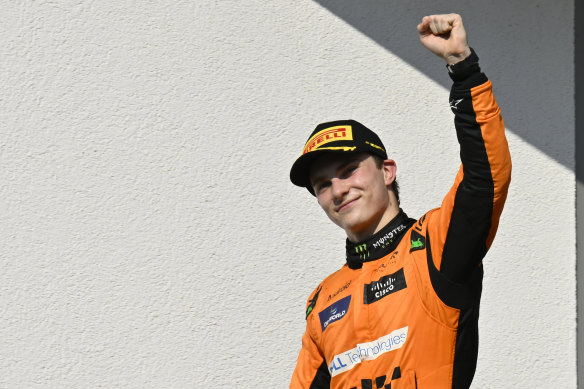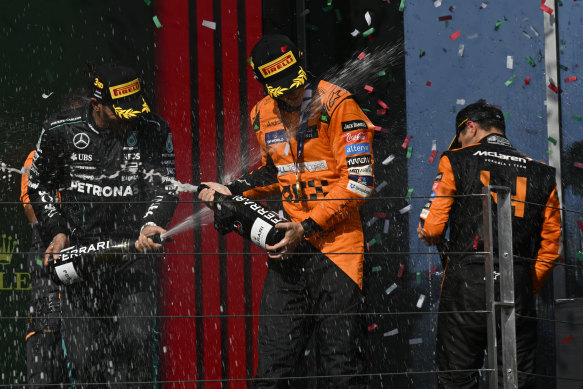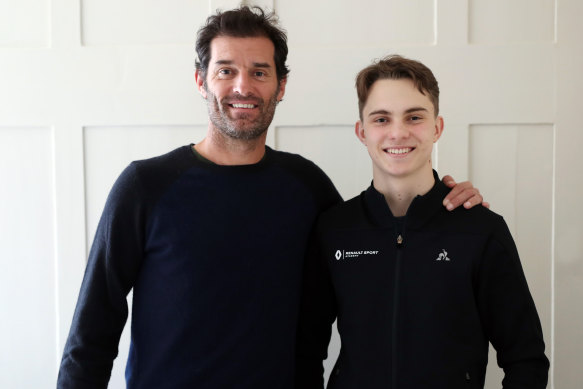This was published 1 year ago
Why did Piastri’s teammate let him win? The high-speed politics of Formula 1
In a cramped Formula 1 cockpit, a driver reaches speeds beyond 350km/h while their body shudders and fights against pulsating G-Force.
It is one of the most mentally and physically demanding places in sport, each split second in a race demands their acute attention. On top of this, they are listening to and responding to team instructions that could change the trajectory of not only a single race, but their career.
In his 35th race, Australian driver Oscar Piastri enjoyed his debut win in the Hungarian Grand Prix after falling on the right side of his team orders, after fellow McLaren driver Lando Norris eventually, and reluctantly, complied with his race engineer.
In Formula 1, team orders are delivered for a variety of different reasons. The team needs to manage not only the pursuit of the drivers’ championship, but also the overall constructors’ championship that brings significant financial rewards through bonuses.
There are clear-cut tactical reasons, but the team often needs to wrestle with far more opaque dynamics between two talented drivers.
There is a No.1 driver and a No.2 driver, with the pecking order generally delineated in terms of contracts and team orders, but this can change during the season, either through changing team strategy, or through the sheer will and talent of the original secondary driver.

McLaren driver Oscar Piastri of Australia celebrates after winning the Hungarian Formula One Grand Prix.Credit: AP
Piastri started the race second behind the pole-sitting Norris, but then beat his British teammate to the first turn.
Norris then took the lead due to a favourable pit-stop strategy, which ultimately McLaren wanted to correct to reward the race’s stronger driver, returning the lead to Piastri.
Multi 2-1
In Formula 1, the phrase “Multi 2-1” has become part of the lexicon when it comes to disobeying team orders. In the 2013 Malaysian Grand Prix, Australian driver Mark Webber’s teammate Sebastian Vettel ignored team orders to press forward and take the victory.
The order, “Multi 2-1,” was code that car No.2 (Webber) should finish ahead of car No.1 (Vettel).
Race engineers and team boss Christian Horner pleaded with Vettel to hold back, but the German driver ultimately ignored them, taking on Webber and winning the race.
Vettel apologised, stating after the race: “I am the black sheep right now ... all I can say is apologies to Mark, the pass was deliberate, obviously I wanted to pass him ... but I didn’t mean to ignore the strategy or the call. I made a mistake, simply.”
However, the damage was done leading to tension between Webber and Vettel.

Piastri (centre) celebrates on the podium with his McLaren teammate Lando Norris (right), who came second, and third-placed Mercedes driver Lewis Hamilton (left).Credit: AP
The battle between one and two
Significantly, Piastri’s manager is Webber. The Australian has shrewdly helped the young driver to navigate the choppy terrain of Formula 1, understanding the almost impossible balance that must be undertaken between diplomacy and personal interest as a driver.
The dynamic between Formula 1 drivers is complex, managing their personal ambitions that will keep them at the top of the sport, while facing pressure to take a team-first approach that, in theory, will ultimately benefit everyone in the long term. Lasting friendships are difficult to sustain in the pit lane.
Norris’ race engineer Will Joseph’s orders over the radio started as cajoling, but swiftly turned into pleading with his driver to think of the team first.
“I’m trying to protect you, mate,” Joseph said. “The way to win a championship is not by yourself. You’re going to need Oscar (Piastri) and you’re going to need the team.”
While Norris remains the No.1 driver at McLaren for now, Piastri’s undoubted talent could change the order in time.
At the mercy of a tactical call
Australian driver Daniel Ricciardo experienced the gradual shift of losing his grip as his team’s top driver at Red Bull, as Max Verstappen emerged from a relative rookie to become an impetuous competitor who would stop at nothing be the main driver of the team.
Verstappen joined midway through the 2016 season, but by the end of 2018, the Australian had left Red Bull for 2018, feeling that the team priorities had switched to the young Dutch driver.

Australian Formula 1 legend Mark Webber with rising star Oscar Piastri.
In Formula 1, a driver is at the mercy of a team, be it the mechanics who ensure the car can compete for victory each race or the race engineers who can change a career forever with a single order in a race.
At the same Hungarian Grand Prix that gave Piastri his debut win, his compatriot Ricciardo, now racing for the RB Formula 1 team(notionally Red Bull’s development team), was fighting to keep his career alive.
Ricciardo was called for a pit stop early as part of his team’s tactical strategy that he felt cost him precious points in the drivers’ championship, and potentially, his future in the sport.
“Honestly, I was expecting more. On the in-lap I was waiting for ‘Sorry, we f---ed up’, and I didn’t get it,” Ricciardo said.
“That made me even more angry ... honestly, as soon as I’m pulling in the pits I’m questioning it, but you can’t (do anything about it).”
News, results and expert analysis from the weekend of sport sent every Monday. Sign up for our Sport newsletter.